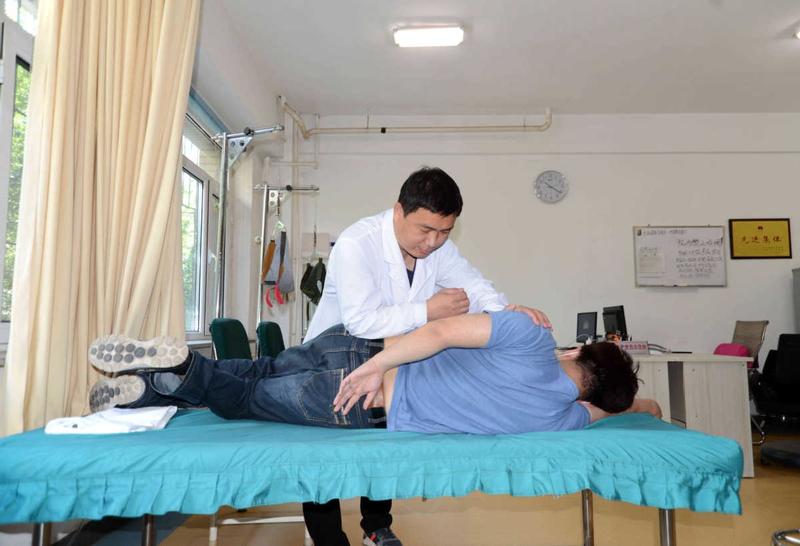Three major indicators confirm great improvements in the province's provision of medical assistance and clinical expertise
 A doctor gives a massage therapy to a patient at a Chinese medicine hospital in Shenyang, Liaoning province, on May 29, 2020. (PHOTO / IC)
A doctor gives a massage therapy to a patient at a Chinese medicine hospital in Shenyang, Liaoning province, on May 29, 2020. (PHOTO / IC)
The Liaoning Provincial Health Commission recently released the Public Health and People's Health Status Report for 2019. According to the document, the basic health indicators of residents in the northeastern province rank among the best in the country.
"We have pushed hard to drive the work forward in recent years because health is people's eternal pursuit. It is related to the happiness of thousands of families. There can be no comprehensive well-off society without health," said Gao Mingyu, deputy director of the Liaoning Provincial Health Commission.
"The focus of our work will shift from healing to overall health. We will implement measures to prevent and control key infectious diseases, such as AIDS and tuberculosis, and promote early screening and comprehensive intervention for chronic illnesses."
The past 100 years have witnessed many achievements in China's social development and great progress in medicine and healthcare. The central government has paid close attention to people's health, making it a development priority.
The provincial government is adhering to a guideline called Healthy Liaoning. As such, it is making great efforts to develop a strong public health system, refine medical service networks in both urban and rural areas, carry out extensive public fitness activities and raise average life expectancy.
Liaoning aims to make breakthroughs in several fields during the 14th Five-Year Plan (2021-25), authorities said. The aims include developing high-quality, efficient healthcare service systems, establishing a strong public health system and promoting reform and institutional innovation, said Hu Miao, an official with the provincial health commission.
The overall health of Liaoning's urban and rural residents has improved significantly according to three main indicators: life expectancy; infant mortality; and maternal mortality.
The past century has seen average life expectancy rise, while the rates of maternal and infant mortality have fallen markedly.
Provincial government statistics show that average life expectancy is now 78.97 years, indicating a steady upward trend in recent years.
In addition, the infant mortality rate is 3.8 per thousand, while the mortality rate of children age 5 and younger in the registered population is 4.6 per thousand. From 2012 to 2019, the mortality rates of infants and children age 5 and younger fell by 9.3 percent and 8.2 percent respectively.
"The three major health indicators have remained at the advanced levels of developed countries or regions for more than 10 years," said Bai Nannan, head of the Liaoning Public Health Service Center.
Investment
Liaoning continues to raise investment in public health. Before 1978, total investment in medical and healthcare was less than 500 million yuan, but in 2017, the province invested 147 billion yuan (US$22.8 billion), Bai said.
Also, medical and health investment as a proportion of GDP rose from 0.8 percent to 6.61 percent over the same period, while investment in fixed assets related to health services grew by more than 20 percent annually.
The infrastructure, equipment allocation and diagnostic and treatment capabilities offered by medical and health institutions at all levels have been greatly strengthened, and medical services have been significantly improved. Individual medical costs have also fallen significantly.
Moreover, construction of the public medical and health service system has provided greater convenience and assistance to Liaoning's residents. Now, more than 80 percent of them can reach the nearest medical institution within 15 minutes.
The per capita subsidy for basic public health rose from 15 yuan in 2009 to 69 yuan in 2019, while 2 million school-age children receive vaccinations free of charge every year.
In 2017, Liaoning provided 200 million outpatient and emergency services, according to the provincial health commission.
To date, Liaoning has established 388 medical treatment partnerships to promote effective cooperation and coordination between different types of institutions. The partnerships cover 18,600 institutions, including all tertiary and county-level hospitals, and six provincial consultation centers have been established. Telemedicine services cover all counties and districts.
Hu said Liaoning will promote the development of regional medical centers and make their development a priority to help balance quality medical resources among all regions during the 14th Five-Year Plan.
The province will continue to reform public hospitals and improve efficiency and the quality of medical care. The aims also include improving the salaries of medical professionals.
The inheritance and innovative development of traditional Chinese medicine is also a priority for the local health commission this year.
In addition, people now have their own family doctors after 14,000 GP teams were set up to promote the gradual transformation of the grassroots service model from intermittent services to continuous and responsible health management.
Contact the writers at wuyong@chinadaily.com.cn


